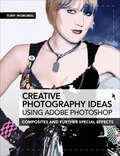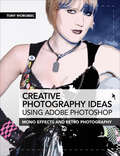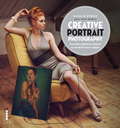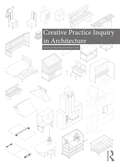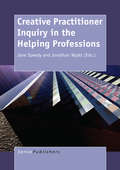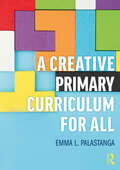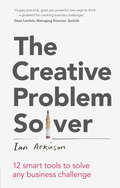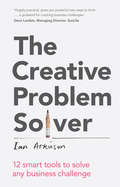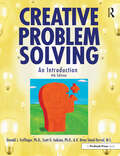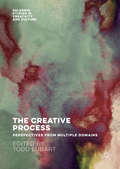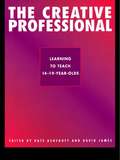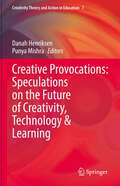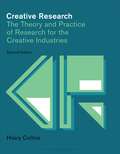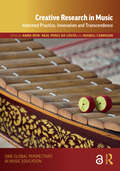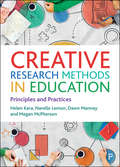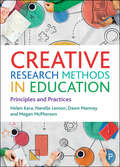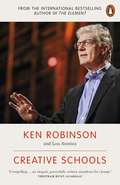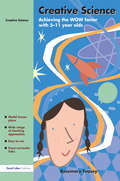- Table View
- List View
Creative Photography Ideas using Adobe Photoshop - Composites and further special effects: 75 Workshops To Enhance Your Photographs
by Tony WorobiecComposites and further special effects is an excerpt from Creative Photography Ideas Using Photoshop which presents 75 comprehensive workshops that have been specifically designed for photographers; each offers a clever and creative technique that can be immediately applied.Composites and further special effects workshops focus specifically on creating composites; from dropping in a sky to producing sunbeams, using multiple files, blending mode, refine edge, the gradient tool, multiple layers. There are plenty of creative ideas that will take your photography that little bit further from creating a 'joiner' or 'still movie' to joining two landscapes and creating a mirror image.Each workshop offers ingenious creative techniques to immediately enhance images in Adobe Photoshop.From basic techniques to more advanced, all guidance is ‘best practice’ and shown via clear explanatory texts, photographs, ‘before, during and after’ manipulations and screen grabs.
Creative Photography Ideas using Adobe Photoshop: Mono effects and retro photography
by Tony WorobiecMono effects and retro photography is an excerpt from Creative Photography Ideas Using Photoshop which presents 75 comprehensive workshops that have been specifically designed for photographers; each offers a clever and creative technique that can be immediately applied.Mono effects and retro photography workshops focus specifically on mono effects such as sepia toning, lith effects, and selective colouring, as well as creating retro photography effects such as pinhole camera, adding borders, and disressing images.Each workshop offers ingenious creative techniques to immediately enhance images in Adobe Photoshop.From basic techniques to more advanced, all guidance is ‘best practice’ and shown via clear explanatory texts, photographs, ‘before, during and after’ manipulations and screen grabs.
Creative Portrait Photography: Innovative Digital Portraiture to Reveal the Inner Subject
by Natalie DybiszThe very best portrait photography strives to give the viewer access into their subject's inner self; to provide a window into their soul. With the advent of the digital age and the potential afforded by post-processing, a whole generation of photographic artists has access to greater creative possibilities than ever before.Spearheading this new breed of creative photographer is author Natalie Dybisz, better known in the photographic community as Miss Aniela. Devoted to exploring portraiture at its most creative portraits with context, story, and constructed elements Creative Portrait Photography takes the reader on a behind-the-scenes journey through the creation of Natalie Dybisz's innovative digital portraits, from first concept to post-processing.Also featuring an extensive showcase chapter in which other photographer-artist's work and working methods are laid bare, Creative Portrait Photography has everything you need to inspire you and transform your perspective on portrait photography.
Creative Practice Inquiry in Architecture
by Ashley Mason Adam SharrThis collection introduces, illustrates, and advances fresh ideas about creative practice inquiry in architecture. It concerns architectural knowledge: how architects can use their distinctive skills, habits, and values to advance professional insight, and how such insights can be extended to make wider contributions to society, culture, and scholarship. It shows how architectural ways of knowing and working can be mobilised as tools for research. Collected here are a series of creative practices that emerge out of architecture and actively engage with other fields and methods reaching across the academic landscape. Architectural inquiries collected in this book probe matters that lie beyond the obvious expectations, the conventions, the default, of the discipline. Drawing, borrowing, adapting, dramatising, perhapsing, monstering, experimenting, cartooning—the tools and methods of each inquiry vary but they all share a common outward gaze, engaging architectural ways of knowing with other disciplines and practices including the arts, biological sciences, ethnography, and technology. Chapters gathered here offer insight not only into incipient modes and tools of architectural research, but emerging ethical, practical, and philosophical positions intimately tied to the creative practices involved. Setting-out the idea of creative practice inquiry in architecture, this innovative volume offers a lively and resourceful contribution to a growing body of work on design as research. It will be of interest to: students keen to pursue architectural ways of thinking and writing; practitioners who want to use their distinctive professional abilities to contribute to architectural and scholarly knowledge; and academics and doctoral candidates keen to engage with the burgeoning scholarly field of design research.
Creative Practice Inquiry in Architecture
by Ashley Mason Adam SharrThis collection introduces, illustrates, and advances fresh ideas about creative practice inquiry in architecture. It concerns architectural knowledge: how architects can use their distinctive skills, habits, and values to advance professional insight, and how such insights can be extended to make wider contributions to society, culture, and scholarship. It shows how architectural ways of knowing and working can be mobilised as tools for research. Collected here are a series of creative practices that emerge out of architecture and actively engage with other fields and methods reaching across the academic landscape. Architectural inquiries collected in this book probe matters that lie beyond the obvious expectations, the conventions, the default, of the discipline. Drawing, borrowing, adapting, dramatising, perhapsing, monstering, experimenting, cartooning—the tools and methods of each inquiry vary but they all share a common outward gaze, engaging architectural ways of knowing with other disciplines and practices including the arts, biological sciences, ethnography, and technology. Chapters gathered here offer insight not only into incipient modes and tools of architectural research, but emerging ethical, practical, and philosophical positions intimately tied to the creative practices involved. Setting-out the idea of creative practice inquiry in architecture, this innovative volume offers a lively and resourceful contribution to a growing body of work on design as research. It will be of interest to: students keen to pursue architectural ways of thinking and writing; practitioners who want to use their distinctive professional abilities to contribute to architectural and scholarly knowledge; and academics and doctoral candidates keen to engage with the burgeoning scholarly field of design research.
Creative Practitioner Inquiry in the Helping Professions
by Jane Speedy Jonathan WyattThis beautiful volume offers a range of research possibilities for practitioners. Bringing together the work of a community of scholars whose work blurs the edges between the arts and social sciences in the name of practice-based inquiry, Creative Practitioner Inquiry in the Helping Professions offers engaging and accessible exemplars alongside clear explanations of the theoretical understandings and backgrounds to the approaches offered. The book’s contributors are teachers, doctors, social workers, counsellors, psychotherapists, health and community workers and organisational consultants; together they passionately engage in arts-based research as an effective and accessible instrument of inquiry, knowledge dissemination and social change.
A Creative Primary Curriculum for All
by Emma L. PalastangaThe curriculum in many primary schools, in recent history, became worryingly narrowed such that children were being prepared for tests more than their lives were being enriched with a variety of knowledge, skills and experiences. It is clear that it is the latter that enables them to perform well in tests and in life, so the time for change is now! This book seeks to empower teachers and school leaders to better understand what is meant by 'curriculum' and what a creative educational diet might look like in each individual school. The book explores curriculum intent, implementation and impact. It includes leaders' reflection boxes and practical suggestions for busy teachers. Emma L. Palastanga analyses the need for a broad and balanced curriculum, against the limitations of cramming for success, and delves deep into the process of curriculum planning, delivery and evaluation, using Ofsted’s terminology. Examples of lessons and a range of different approaches are shared throughout the book. A Creative Primary Curriculum for All will give all subject leaders, classroom teachers and teacher trainees the confidence to provide a rich, exciting and varied curriculum, meeting the needs of learners whilst also letting the craft of teaching and individual inspiration shine.
A Creative Primary Curriculum for All
by Emma L. PalastangaThe curriculum in many primary schools, in recent history, became worryingly narrowed such that children were being prepared for tests more than their lives were being enriched with a variety of knowledge, skills and experiences. It is clear that it is the latter that enables them to perform well in tests and in life, so the time for change is now! This book seeks to empower teachers and school leaders to better understand what is meant by 'curriculum' and what a creative educational diet might look like in each individual school. The book explores curriculum intent, implementation and impact. It includes leaders' reflection boxes and practical suggestions for busy teachers. Emma L. Palastanga analyses the need for a broad and balanced curriculum, against the limitations of cramming for success, and delves deep into the process of curriculum planning, delivery and evaluation, using Ofsted’s terminology. Examples of lessons and a range of different approaches are shared throughout the book. A Creative Primary Curriculum for All will give all subject leaders, classroom teachers and teacher trainees the confidence to provide a rich, exciting and varied curriculum, meeting the needs of learners whilst also letting the craft of teaching and individual inspiration shine.
The Creative Problem Solver: 12 tools to solve any business challenge
by Ian AtkinsonProblem solving tools to solve any business challenge. Using proven, innovative techniques from some major players in the business world, this is the go-to book for every professional who wants to find better answers to their business challenges.
The Creative Problem Solver: 12 tools to solve any business challenge
by Ian AtkinsonProblem solving tools to solve any business challenge. Using proven, innovative techniques from some major players in the business world, this is the go-to book for every professional who wants to find better answers to their business challenges.
Creative Problem Solving: An Introduction
by Donald J. Treffinger Scott G. Isaksen K. Brian Stead-DorvalCreative Problem Solving is a process that allows people to apply both creative and critical thinking to find solutions to everyday problems. Creative Problem Solving eliminates the tendency to approach problems in a haphazard manner and, consequently, prevents surprises and/or disappointment with the solution.Used by thousands of group leaders seeking a friendly introduction to using Creative Problem Solving, this book is a time-honored classic. Creative Problem Solving: An Introduction is based on more than five decades of extensive research, development, and field experience in educational settings, businesses, and many other organizations.Written for both group leaders and individuals seeking a systematic way to build innovative and effective solutions, Creative Problem Solving is perfect for any type of setting.This definitive guide shows you how to find successful solutions to important challenges. Creative Problem Solving (CPS) can help your students to approach problems and deal with change in a deliberate and constructive way, building their confidence and success in working with complex issues.This revised and updated fourth edition includes: easy-to-follow instructions for using Creative Problem Solving; practical tools for understanding the challenge, generating ideas, and preparing for action; expanded guidelines for planning your approach to Creative Problem Solving; strategies that ensure successful group dynamics; the latest trends in creative thinking and group problem solving; and practical suggestions for those new to Creative Problem Solving.Educational Resource
Creative Problem Solving: An Introduction
by Donald J. Treffinger Scott G. Isaksen K. Brian Stead-DorvalCreative Problem Solving is a process that allows people to apply both creative and critical thinking to find solutions to everyday problems. Creative Problem Solving eliminates the tendency to approach problems in a haphazard manner and, consequently, prevents surprises and/or disappointment with the solution.Used by thousands of group leaders seeking a friendly introduction to using Creative Problem Solving, this book is a time-honored classic. Creative Problem Solving: An Introduction is based on more than five decades of extensive research, development, and field experience in educational settings, businesses, and many other organizations.Written for both group leaders and individuals seeking a systematic way to build innovative and effective solutions, Creative Problem Solving is perfect for any type of setting.This definitive guide shows you how to find successful solutions to important challenges. Creative Problem Solving (CPS) can help your students to approach problems and deal with change in a deliberate and constructive way, building their confidence and success in working with complex issues.This revised and updated fourth edition includes: easy-to-follow instructions for using Creative Problem Solving; practical tools for understanding the challenge, generating ideas, and preparing for action; expanded guidelines for planning your approach to Creative Problem Solving; strategies that ensure successful group dynamics; the latest trends in creative thinking and group problem solving; and practical suggestions for those new to Creative Problem Solving.Educational Resource
The Creative Process: Perspectives from Multiple Domains (Palgrave Studies in Creativity and Culture)
by Todd LubartThe creative process refers to the sequence of thoughts and actions that are involved in the production of new work that is both original and valuable in its context. This book examines this process across the domains of visual art, writing, engineering, design and music. It characterizes each domain’s creative process based on evidence stemming from creators’ accounts of their own activity and a wide-range of observational material and theories specific to each field. Results from empirical research are then presented across a set of closely linked chapters, using a common set of methodologies that seek to trace the creative process as it unfolds. This highly interdisciplinary edited collection offers valuable insight into the creative process for scholars and practitioners in the fields of psychology, education, and creative studies, as well as for any other readers interested in the creative process. Todd Lubart brings together a group of authors who are themselves actively involved in their respective creative fields and invites readers to adopt a broad perspective on the creative process in order to unravel some of its mysteries.
CREATIVE PROFESSIONAL: Learning To Teach 14-19-year-olds
by Kate Ashcroft David JamesThis volume looks at the role of the teacher in the classroom, the dilemmas they face, what it means to be a professional in this context and the wider professional role of the teacher in secondary schools and colleges. Case studies are used to introduce the main context, linked to enquiry tasks which address: meanings of professionalism and their implications; professional approaches to teaching; power and relationships; inter-professional and inter-institutional issues.
CREATIVE PROFESSIONAL
by Kate Ashcroft David JamesThis volume looks at the role of the teacher in the classroom, the dilemmas they face, what it means to be a professional in this context and the wider professional role of the teacher in secondary schools and colleges. Case studies are used to introduce the main context, linked to enquiry tasks which address: meanings of professionalism and their implications; professional approaches to teaching; power and relationships; inter-professional and inter-institutional issues.
Creative Provocations: Speculations on the Future of Creativity, Technology & Learning (Creativity Theory and Action in Education #7)
by Danah Henriksen Punya MishraThis book explores the complex, yet critical, relationship between technology and creativity, specifically in educational contexts. Creativity is important for success in today’s rapidly changing, radically contingent and hyperconnected world. This is even more relevant in the context of teaching and learning—where the psychological, sociological and cultural aspects of human learning confront the challenges of a rapidly changing, technologically saturated world. Written by some of the foremost thinkers and researchers in the area of creativity and/or technology, the chapters in this volume examine the impact of recent and future technologies on creativity, teaching and learning. Individually and collectively, they help us develop an understanding of this nexus of creativity and technology for education. They offer new perspectives on this rapidly evolving future—exploring issues, paradoxes, tensions, and points of interest for creativity and technology. They position these issues in ways that consider implications for thinking, learning, teaching, and education in general.
Creative Research: The Theory and Practice of Research for the Creative Industries
by Hilary CollinsAcademic research in design can seem daunting – let Hilary Collins show you the building blocks of a great final project. The perfect companion for a research project in fashion, design or visual communication, this 2nd edition of Creative Research walks you through:· Choosing a topic· Deciding your approach· Using previous research and writing a literature review· Obtaining your own data and using it appropriatelyUseful case studies show best practice, revealing the links between a researcher's choice of method and the conclusions they draw. Packed with advice on how to manage your time and structure your project effectively, this edition also includes new sections on design thinking and ethnography.Collins marries theory and practice from start to finish, showing you everything you need to confidently embark on your creative research project.
Creative Research: The Theory and Practice of Research for the Creative Industries (Required Reading Range Ser.)
by Hilary CollinsAcademic research in design can seem daunting – let Hilary Collins show you the building blocks of a great final project. The perfect companion for a research project in fashion, design or visual communication, this 2nd edition of Creative Research walks you through:· Choosing a topic· Deciding your approach· Using previous research and writing a literature review· Obtaining your own data and using it appropriatelyUseful case studies show best practice, revealing the links between a researcher's choice of method and the conclusions they draw. Packed with advice on how to manage your time and structure your project effectively, this edition also includes new sections on design thinking and ethnography.Collins marries theory and practice from start to finish, showing you everything you need to confidently embark on your creative research project.
Creative Research in Music: Informed Practice, Innovation and Transcendence (ISME Series in Music Education)
by Anna Reid Neal Peres Da Costa Jeanell CarriganCreative Research in Music explores what it means to be an artistic researcher in music in the twenty-first century. The book delineates the myriad processes that underpin successful artistic research in music, providing best practice exemplars ranging from Western classical art to local indigenous traditions, and from small to large-scale, multi-media and cross-cultural work formats. Drawing on the richness of creative research work at key institutions in South-East Asia and Australian, this book examines the social, political, historical and cultural driving forces that spur and inspire excellence in creative research to extend and to cross boundaries, to sustain our music industry, to advocate for the importance of music in our world, and to make it clear that music matters.In the chapters, our authors present the ideas of informed practice, innovation and transcendence from diverse international perspectives. Each of these three themes has an introductory section where the theme is explored and the chapters in that section introduced. Taken as a whole, the book discusses how the themes in combination, with reference to the authorial group, are able to transform music pedagogy and performance for our global and complex world.Chapter 9 of this book is freely available as a downloadable Open Access PDF at http://www.taylorfrancis.com under a Creative Commons Attribution-Non Commercial-No Derivatives (CC-BY-NC-ND) 4.0 license.
Creative Research in Music: Informed Practice, Innovation and Transcendence (ISME Series in Music Education)
by Anna Reid Costa, Neal Peres Da Jeanell CarriganCreative Research in Music explores what it means to be an artistic researcher in music in the twenty-first century. The book delineates the myriad processes that underpin successful artistic research in music, providing best practice exemplars ranging from Western classical art to local indigenous traditions, and from small to large-scale, multi-media and cross-cultural work formats. Drawing on the richness of creative research work at key institutions in South-East Asia and Australian, this book examines the social, political, historical and cultural driving forces that spur and inspire excellence in creative research to extend and to cross boundaries, to sustain our music industry, to advocate for the importance of music in our world, and to make it clear that music matters.In the chapters, our authors present the ideas of informed practice, innovation and transcendence from diverse international perspectives. Each of these three themes has an introductory section where the theme is explored and the chapters in that section introduced. Taken as a whole, the book discusses how the themes in combination, with reference to the authorial group, are able to transform music pedagogy and performance for our global and complex world.Chapter 9 of this book is freely available as a downloadable Open Access PDF at http://www.taylorfrancis.com under a Creative Commons Attribution-Non Commercial-No Derivatives (CC-BY-NC-ND) 4.0 license.
Creative Research Methods in Education: Principles and Practices
by Helen Kara Narelle LemonCo-authored by an international team of experts across disciplines, this important book is one of the first to demonstrate the enormous benefit creative methods offer for education research. You do not have to be an artist to be creative, and the book encourages students, researchers and practitioners to discover and consider new ways to explore the field of education. It illustrates how using creative methods, such as poetic inquiry, comics, theatre and animation, can support learning and illuminate participation and engagement. Bridging academia and practice, the book offers: • practical advice and tips on how to use creative methods in education research; • numerous case studies from around the world providing real-life examples of creative research methods in education practice; • reflective discussion questions to support learning.
Creative Research Methods in Education: Principles and Practices
by Helen Kara Narelle LemonCo-authored by an international team of experts across disciplines, this important book is one of the first to demonstrate the enormous benefit creative methods offer for education research. You do not have to be an artist to be creative, and the book encourages students, researchers and practitioners to discover and consider new ways to explore the field of education. It illustrates how using creative methods, such as poetic inquiry, comics, theatre and animation, can support learning and illuminate participation and engagement. Bridging academia and practice, the book offers: • practical advice and tips on how to use creative methods in education research; • numerous case studies from around the world providing real-life examples of creative research methods in education practice; • reflective discussion questions to support learning.
Creative Schools: Revolutionizing Education from the Ground Up
by Sir Ken Robinson Lou AronicaFrom the international bestselling author of The ElementKen Robinson is one of the world's most influential voices in education. In this inspiring, empowering book, he sets out a new vision for how education can be transformed to enable all young people to flourish. Filled with practical examples and groundbreaking research, it will inspire the change our children urgently need.'Compelling ... an elegant, powerfully written manifesto for change' Tristram Hunt, Guardian 'Inspires and brings a new sense of possibility to the goal of transforming education . . . This is a global game-changer' Brené Brown, author of Daring Greatly'Wonderful and enjoyable' Malala Yousafzai, Nobel Prize Laureate
Creative Science: Achieving the WOW Factor with 5-11 Year Olds
by Rosemary FeaseyThrough a refreshing blend of theory and practice this book provides stimulating material to develop creative approaches to science in the classroom. It includes: a range of teaching approaches that relate directly to the topic under discussion examples of pupils' work that portray how theory can be translated into practice quick off-the-shelf example model lesson plans which can be adapted. User-friendly and clearly laid out this book is a core text for primary teachers, NQTs and students who want to inject some creativity into their teaching and put that "WOW" factor back into their science lessons.
Creative Science: Achieving the WOW Factor with 5-11 Year Olds
by Rosemary FeaseyThrough a refreshing blend of theory and practice this book provides stimulating material to develop creative approaches to science in the classroom. It includes: a range of teaching approaches that relate directly to the topic under discussion examples of pupils' work that portray how theory can be translated into practice quick off-the-shelf example model lesson plans which can be adapted. User-friendly and clearly laid out this book is a core text for primary teachers, NQTs and students who want to inject some creativity into their teaching and put that "WOW" factor back into their science lessons.
